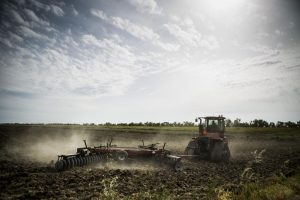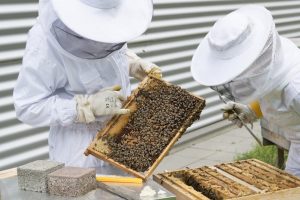6 Thriving or Threatened?
Why did the bee get in trouble? They weren’t bee-hiving themselves
There are many theories that explain why bumble bee populations have declined over the years. Many researchers agree that things such as pesticide use in farms and a decrease in bumble bee habitat are some of the leading causes for these population declines. When farming is conducted on a large scale we refer to this as industrial agriculture. To make industrial agriculture efficient, large fields are planted with a single crop to make harvesting easier. This practice is called monoculture and it reduces the biodiversity of an area as there is only one species of plant present as opposed to many different species like what we would see in a natural habitat.

Bumble bees depend on a wide variety of plant species for foraging, therefore, when an entire field is planted with a crop that they are unable to forage on throughout their lifetime, they are unable to thrive in that area. Having a large diversity of flowers available for bees is essential for bumble bee survival.
As we previously mentioned in Chapter 3, non-native species such as honey bees also have a negative impact on native bumble bee species. Non-native bees compete with bumble bees for food and other resources and they can also introduce dangerous pathogens that can harm or kill bumble bees. When humans introduce non-native bees as pollinators for agricultural purposes or when they start a commercial beekeeping operation with honey bees, this can deter native bumble bees from that area.

Additionally, climate change has a big impact on bumble bee survival. Fluctuating weather patterns, changing flower blooming times, and temperature extremes all influence a bumble bee’s ability to thrive.
Overall, bumble bee populations are very much at risk. Species such as the yellow-banded bumble bee and the gypsy cuckoo bumble bee in particular have been significantly impacted by human activity. It is our responsibility to do what we can to protect these important pollinators for the wellbeing of the natural environment.
Source: Bartomeus Lab (2016). View site.
Let’s put what we have learned thus far to the test. In the following quiz, fill in the missing words to show that you’ve grasped the concepts we have discussed in this chapter.
A harmful substance that kills living things such as plants, insects, or fungi. These chemicals are often used in industrial agriculture practices.
Large scale farming practices that are often harmful to the environment due to pesticide use and the use of heavy machinery that run on fossil fuels. These practices, require a large amount of water, lower biodiversity, and can deplete soil nutrients.
A habitat that is made up of a variety of different species which means that it is healthy and resilient to environmental disturbances such as climate change. Human disturbances can have a negative impact on biodiversity.
The action of a bumble bee gathering pollen and nectar.
A species that has been introduced to an area that is not within its natural range by humans. Can also be referred to as an invasive species in some circumstances.
Apis mellifera. A non native species of bee that was introduced to Canada by humans. These bees are used in commercial settings and they are farmed for their honey production.
A dangerous organism that can harm another living thing by giving them a disease or illness.
A change in the average conditions — such as temperature and rainfall — in a region over a long period of time (Source: NASA Climate Kids. Visit Site.)

